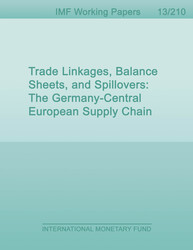
Trade Linkages, Balance Sheets, and Spillovers: The Germany-Central European Supply Chain
WP/13/210
Germany and the Czech Republic, Hungary, Poland, and Slovakia (the CE4) have been in aprocess of deepening economic integration which has lead to the development of a dynamicsupply chain within Europe—the Germany-Central European Supply Chain (GCESC).Model-based simulations suggest two key policy implications: First, as a reflection ofstrengthening trade linkages, German fiscal spillovers to the CE4 and more broadly to therest of the euro area, have increased over time, but are still relatively small. This is explainedby the supply chain nature of trade integration: final demand in Germany is not necessarilythe main determinant of CE4 exports to Germany. Second, increased trade openness in bothGermany and the CE4 implies a greater exposure of the GCESC to global shocks. However,owing to its strong fundamentals—including sound balance sheets and its safe haven status—Germany plays the role of a regional anchor of stability by better absorbing shocks fromother trading partners instead of amplifying their transmission across the GCESC.
Publication date: October 2013
ISBN: 9781484355183
$18.00
Add to Cart by clicking price of the language and format you'd like to purchase
Available Languages and Formats
| English |
Prices in red indicate formats that are not yet available but are forthcoming.
Topics covered in this book
This title contains information about the following subjects.
Click on a subject if you would like to see other titles with the same subjects.
Germany , Czech Republic , Hungary , Poland , Slovakia , vertical integration , verticalspecialization , supply chain , fiscal policy , balance sheets , spillovers , DSGE models , financialaccelerator
Summary
Copyright © 2010 - 2024
Powered by:
AIDC



